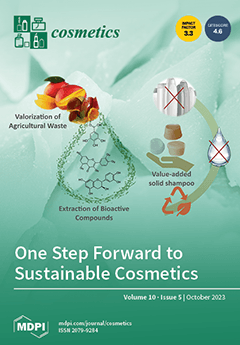Oral malodor, often known as halitosis, is an irritating breath odor that originates in the mouth and can cause significant psychological and social distress. Chlorhexidine, a powerful antimicrobial agent effective against bacteria and fungi, has become the standard treatment for halitosis. However, it has drawbacks including altered taste perception, dry mouth, and more noticeable dental staining. The use of natural essential oils to avoid these unwanted effects has proven to be an attractive strategy. This study aims to evaluate the potential of four essential oils consisting of Ma-kwean fruit (
Zanthoxylum limonella, MK), clove bud (
Syzygium aromaticum, CV), star anise fruit (
Illicium verum, SA) and cinnamon bark (
Cinnamomum aromaticum, CM) for the purpose of combating bad breath by assessing their antibacterial efficacy against halitosis-associated bacteria (
Streptococcus mutans and
Solobacterium moorei). The hydro-distillation process was used to prepare the essential oils, which were obtained as yellowish to colorless liquids with yields of 6.58 ± 0.81, 12.21 ± 2.98, 4.29 ± 0.15 and 1.26 ± 0.09% for MK, CV, SA and CM, respectively. The terpenoid compounds terpinene-4-ol (47.04%), limonene (17.19%), sabinene (13.27%) and alpha-terpineol (6.05%) were found as the main components in MK essential oil, while phenylpropanoids were identified as the primary components of other essential oils, namely trans-cinnamaldehyde (83.60%), eugenol (83.59%) and anethol (90.58%) were identified as the primary components of CM, CV and SA essential oils, respectively. For the antibacterial properties, the minimal inhibitory concentration (MIC) and minimal bactericidal concentration (MBC) values were investigated. CM essential oil exhibited the greatest capacity to inhibit growth and eradicate
S. mutans, with MIC and MBC values of 0.039%, followed by CV (MIC of 0.078% and MBC of 0.156%) and MK (MIC and MBC of 0.156%), whereas the MIC of SA was 1.250% without eradication. Both CM and CV essential oils demonstrated exceptional efficacy against
S. moorei, with MIC and MBC values of 0.019% and 0.033%, respectively. Furthermore, the inhibition of
S. moorei biofilm formation was investigated and we discovered that the lowest effective concentration necessary to eliminate the
S. moorei biofilm was one quarter of the MIC for MK, CM and CV, while that for SA essential oil was half of the MIC. These encouraging results suggest that the incorporation of MK, CM and CV essential oils into oral care products could potentially enhance their efficacy in halitosis treatment.
Full article





